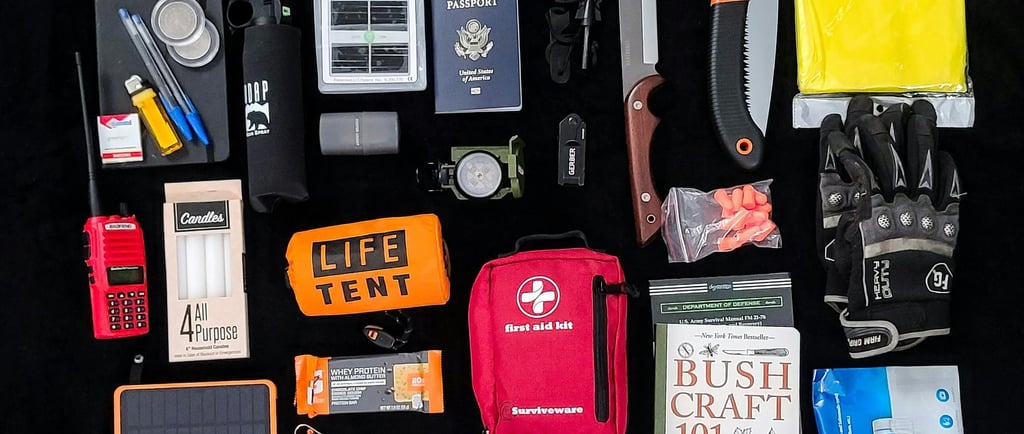25 Essential First Aid Kit Items for Solo Backpackers
BACKCOUNTRY


As a solo backpacker, venturing into the wilderness can be exhilarating but also comes with its share of risks. Whether you’re hiking through remote trails or camping in secluded areas, having a well-prepared first aid kit can be a lifesaver. Here's a rundown of essential items every solo backpacker should include in their first aid kit:
1. Adhesive Bandages: Various sizes of adhesive bandages are essential for covering minor cuts, blisters, and abrasions. Make sure to include waterproof bandages for durability in outdoor conditions.
2. Elastic bandage: An elastic bandage may help provide compression and support to injured joints or muscles, aiding in reducing swelling and promoting healing.
3. Gauze Pads and Tape: Gauze pads are versatile for dressing larger wounds, while medical tape secures bandages and gauze in place.
4. Moleskin: Moleskin is commonly used as a protective padding for blisters and hot spots on the skin, particularly on the feet.
5. Antiseptic Wipes: These wipes are crucial for cleaning wounds and preventing infection, especially when access to clean water is limited.
6. Antibacterial Ointment: Apply antibacterial ointment to cuts and scrapes to prevent infection and promote healing.
7. Pain Relievers: Include over-the-counter pain relievers such as ibuprofen or acetaminophen for relief from minor aches, pains, and headaches.
8. Personal Medications: Carry any necessary prescription medications along with a few extra doses in case of unexpected delays.
9. Antihistamines: Antihistamines can provide relief from allergic reactions, insect bites, and stings. They're essential for managing allergic symptoms away from medical facilities. Antihistamines can include types that are applied topically or orally.
10. Sterile Saline Solution: Saline solution is ideal for flushing out debris from eyes or wounds when clean water isn't available.
11. Tweezers: Tweezers are handy for removing splinters, ticks, and other debris from the skin.
12. Lightweight syringe: A syringe can be used for administering medications, cleaning wounds, applying topical treatments, suctioning fluids, and drawing blood samples as necessary in emergency medical situations.
13. Scissors: Compact, sharp scissors are useful for cutting bandages, tape, and clothing in emergency situations.
14. Medical Gloves: Disposable medical gloves help maintain hygiene when treating wounds and handling bodily fluids.
15. Safety Pin: A safety pin can be used for securing bandages or clothing, removing splinters, or creating makeshift slings or immobilization devices in emergency situations.
16. CPR Face Shield: A CPR face shield provides protection when administering CPR to prevent direct contact with the person’s mouth.
17. Emergency Contact Information: Include a list of emergency contacts, medical information, and any relevant allergies or medical conditions.
18. First Aid Manual: A compact first aid manual or guidebook can provide valuable instructions on treating common injuries and emergencies.
19. Tourniquet: While not often needed, a tourniquet can be a life-saving tool in severe bleeding situations.
20. Whistle: A whistle can help signal for help in case of an emergency when voice communication is not possible.
21. Multi-tool or Swiss Army Knife: A multi-tool or Swiss Army Knife can be invaluable for various tasks, including cutting, opening cans, and more.
22. Water Purification Tablets: In the event of running out of clean water, water purification tablets can make unsafe water drinkable.
23. Emergency Signal Device: Consider carrying a personal locator beacon (PLB) or satellite messenger device for summoning help in remote areas.
24. Paper and Pencil: A paper and pencil may come in handy when documenting vital signs, injury details, treatment administered, and communication in emergency situations where electronic devices may not be available or practical.
25. Warm blanket: Compact emergency blankets made of materials like Mylar or other metallic-coated films are used to provide protection from the elements in case of emergencies such as hypothermia or unexpected weather events.
Remember, while having a well-stocked first aid kit is essential, it's equally important to know how to use its contents. Consider taking a basic first aid course before embarking on your solo backpacking adventures to ensure you're prepared for any situation that may arise. Stay safe, and happy trails!
